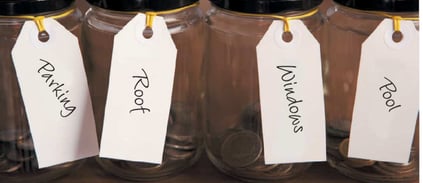
Almost everyone is aware an association needs to have a capital reserve account to set aside money for future capital improvements. Less known is the concept of also budgeting for unexpected operating needs. What’s the Difference?
Operating expenses are expenses incurred in the normal annual business cycle. These might include:
• Lawn maintenance
• Utilities
• Pool contracts
• Snow removal
Reserve expenses are typically for work that improves or replaces capital items with a lifetime of longer than one year. Reserve expenses are not expenses you expect to see on an annual basis. Examples include:
• Parking lot sealing
• Roof replacement
• Pool whitecoating
• Window replacement
It’s All the Same Money, Right?
Ah, the common trap. If you’ve been in management or on a board any length of time, you most likely have heard the suggestion to just use some reserve funds for a budget shortfall. Not so fast. Often reserve funds come with restrictions. Some documents set strict restrictions on how reserve funds can be used and you may need approval from your membership to use funds for operating expenses.
Reserve funds are specifically set aside for capital improvements and should not be accessed at will for extra operating expenses that may come along. If permitted to use reserve funds for an operating shortfall, make strict plans on how to repay the reserve account. Without a plan, there’s good chance those monies will “disappear” into the operating black hole and never be repaid.
Operating Contingency versus Operating Reserves:
An operating contingency line item in the budget is simply what the name implies – a line item in the budget that provides extra support for expenses in the current year’s budget. To take care of potential overages in the budget, you insert a contingency line item in the current budget and fund it at an amount that can absorb some overages in various expenses line items.
An operating reserve is different from an operating contingency in that it is built up over multiple years as opposed to being funded in one specific year’s budget. The purpose of the operating reserve is to budget for large, unexpected operating expenses that occasionally arise.
Funding the operating reserve fund is typically done over multiple years. Instead of dramatically increasing the budget next year, add an operating reserve line item (nothing is actually expensed to this category) to account for large possible swings in expenses.
